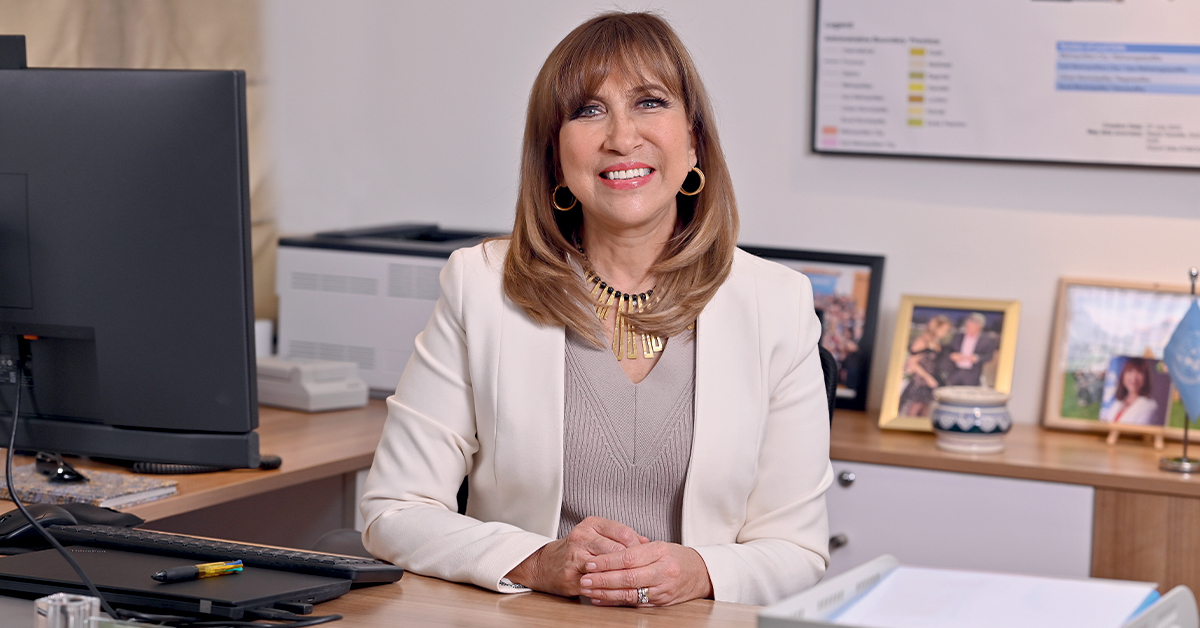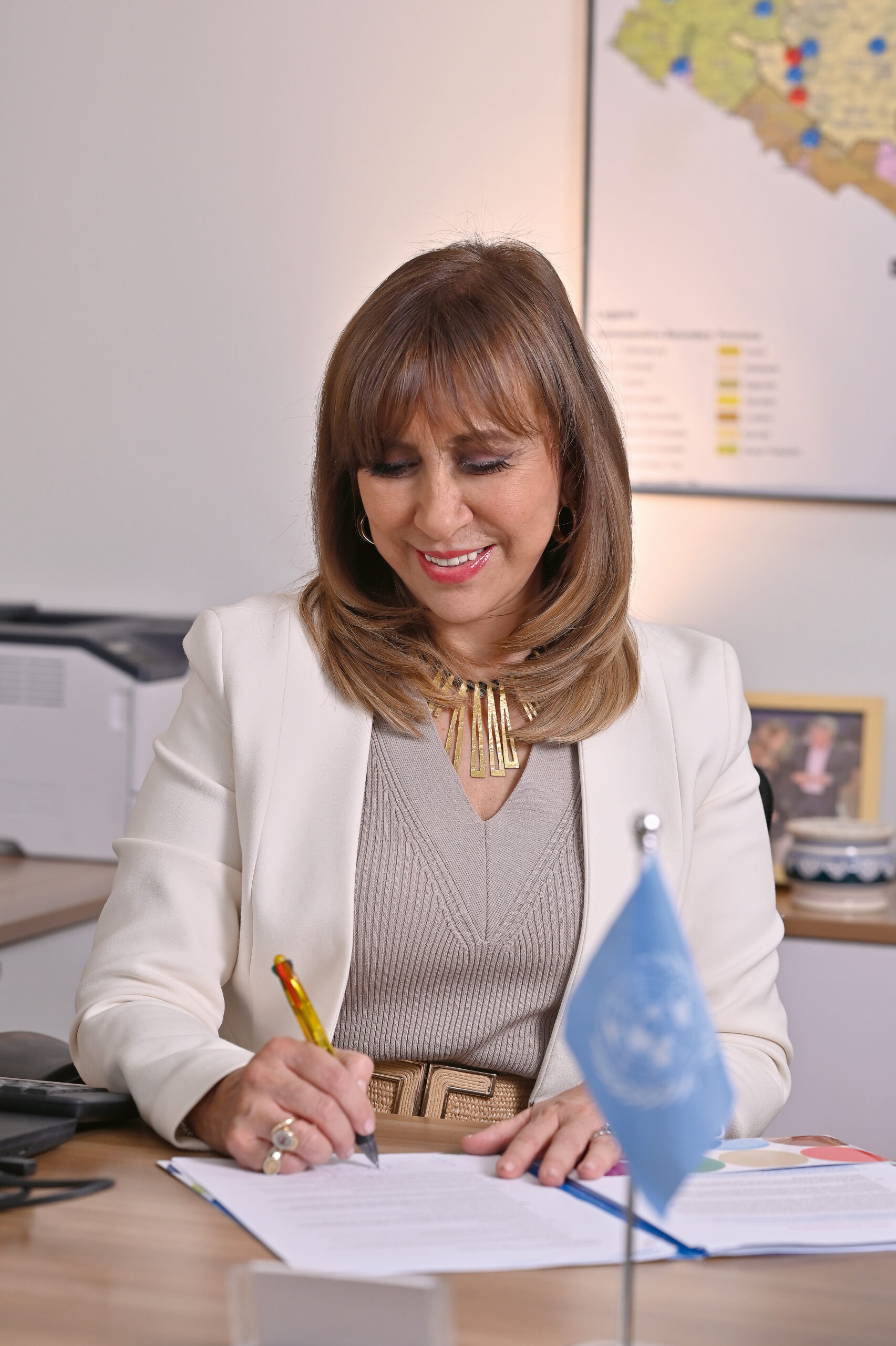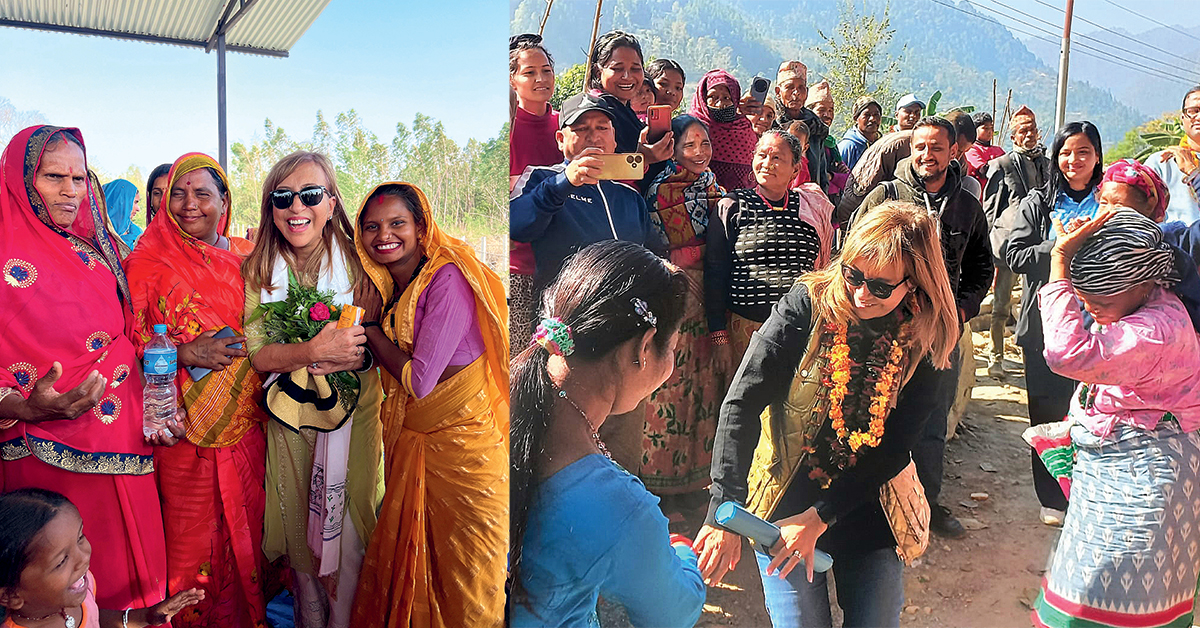
United Nations Resident Coordinator to Nepal, Her Excellency Hanaa Singer-Hamdy, is among the most popular diplomats currently serving in Nepal. Appointed by UN Secretary-General Antonio Guterres, she officially presented her credentials on April 4, 2023, and has since become a well respected figure in Nepal’s diplomatic circles.
As the highest-ranking official of the UN Development System in Nepal, the Egyptian diplomat leads the UN Country Team and coordinates UN support to Nepal in implementing the 2030 Agenda for Sustainable Development. Known for her dedication and pleasantly bold personality, Hanaa is a strong advocate of multilateralism; and has worked for close to three decades across development and humanitarian contexts at various senior management and strategic leadership roles.
Prior to her current posting, she served as the UN Resident Coordinator in Sri Lanka from 2018 to 2022. She was also the UNICEF Representative in Nepal from 2011 to 2014.
In her words, the UN remains fully committed to walking with Nepal on this journey — as a trusted partner, advocate, and ally. Over the past two years, Hanaa has traveled extensively across Nepal, meeting diverse groups of people and gaining first hand insight into the opportunities and challenges.
In an exclusive interview with The Diplomat Nepal, Jagadishor Panday spoke with RC Hanaa about her experiences, reflections, and her engagement with her diplomatic journey in Nepal.
Excerpt:
The United Nations and Nepal share a deep, enduring partnership that spans nearly seven decades. This year marks 70 years since Nepal joined the UN in 1955 — a milestone that reflects a relationship built on mutual trust, shared values, and a commitment to progress.
Over the years, our collaboration has evolved across many fronts along with the needs of the country. From initial support to infrastructure to community-led initiative, and with the turn of the century support for peacebuilding, development, and humanitarian action. One of the most defining chapters in our partnership has been the UN’s support for Nepal’s nationally led homegrown peace process following the decade-long conflict. The establishment of the UN Mission in Nepal (UNMIN) played a vital role in supporting the transition, including the historic Constituent Assembly elections and the disarmament process. This was a moment where global support met national ownership — and together, we helped lay the groundwork for a more peaceful and democratic Nepal.

Our work has touched the lives of millions of people across the country — supporting efforts in water and sanitation, child and maternal health, food security, agricultural innovation, local governance support, labour, heritage, climate, gender, disaster risk reduction and much more.
With the country gearing to graduate from the Least Developed Country (LDC) category, our focus is now less on service delivery and more on system strengthening and policy reform in all the sectors, in addition to supporting the government in its endevours for a smooth, sustainable transition.
With the country bearing the brunt of the climate crisis, we’ve been working closely on disaster preparedness, climate adaptation, and environmental resilience. We proudly support Nepal’s growing voice in climate diplomacy and its leadership on global platforms.
Gender equality and social inclusion have also been central to our partnership with the government. From advancing women’s political participation to tackling gender-based violence and harmful practices, we’ve seen important progress — although there is still much to do to ensure every woman and girl can thrive in an equal and just society.
Our collaboration also spans human rights, youth empowerment, education, health, disaster risk reduction, and sustainable development — areas that directly impact people’s everyday lives. As we celebrate 70 years of UN–Nepal partnership, we not only look back with pride, but also look forward with resolve to assist in building a future that reflects the hopes and ambitions of all Nepalis.
I had the privilege of serving as UNICEF Representative from 2011 to 2014, where I was privileged to travel to over 54 districts, including walking from Jumla to Rara, trekking through Humla, Dolpo, and Upper Mustang. Those journeys weren’t just physical— they were deeply personal. They connected me to the resilience, warmth, and spirit of the Nepali people in a way that never left me. I still get goosebumps when I think of the sight of the amazing Shey Phoksundo lake nestled between mountains at a height of over 3600m.

Since my return, the work has been both deeply fulfilling and meaningful. I arrived just as Nepal and the UN were launching a new phase of our partnership through the 2023–2027 Cooperation Framework. It was also the midpoint of the global SDGs — a moment of reflection and re-commitment. I was proud to work closely with my UN colleagues and the National Planning Commission and many partners across the country to launch the SDG Acceleration Campaign, holding open, honest conversations in communities all over Nepal. It was a really special nationwide engagement where people were eager to shape their future.
One of the moments I’m most proud of is Nepal becoming the first country in the world to integrate the UN’s Six Transitions framework to accelerate the SDG into its national development plan. That decision speaks volumes about Nepal’s leadership, and about our partnership — grounded in trust, respect, and a shared vision of inclusive, sustainable development.
Of course, Nepal faces complex challenges — the political landscape is ever-shifting, and long-term planning isn’t always easy. But what keeps me hopeful — and inspired — is the unwavering determination I see in people at all levels across this country. That energy fuels everything we do at the UN.
So yes, I’m very grateful to be here, working alongside so many dedicated people, in a country I care about so deeply.
In today’s world of rapid change — from geopolitical tensions to technological disruption and climate emergencies — multilateral diplomacy is more vital than ever. No single country can tackle global challenges like pandemics, climate change, or artificial intelligence alone. These issues cross borders and demand collective solutions. Multilateral diplomacy provides the platform for countries to come together, share responsibility, and work toward common goals not because they are the same, but because they recognize their futures are linked.
Recent efforts, like the Pact for the Future adopted at the 2024 Summit of the Future, show how global cooperation can address urgent gaps in areas like Artificial Intelligence governance, digital space, and global health — while keeping people, planet, and peace at the center.
As the UN Secretary-General said, “Multilateralism must be retooled for the 21st century — not as a matter of preference, but of survival.” In an interconnected world, working together isn’t optional — it’s essential.
As the UN Resident Coordinator in Nepal — and the designated representative of the UN Secretary-General — my role is to connect global commitments with national priorities. I lead the coordination of over 20 UN agencies to ensure our efforts are aligned, efficient, and supportive of Nepal’s development agenda, including the 16th Five-Year Plan and the Sustainable Development Goals.
This work involves translating global agreements — such as the Pact for the Future adopted in 2024 — into actionable strategies on the ground. A key focus right now is supporting Nepal’s smooth, sustainable, and inclusive graduation from Least Developed Country (LDC) status by 2026, which requires strong multilateral partnerships.
But beyond coordination, leadership in multilateral diplomacy means creating space for honest dialogue, even when it is difficult. It’s about building bridges between development and diplomacy, global frameworks and grassroots realities, and between the government and its partners. At its core, the role is about upholding the principles of the UN Charter — advocating for inclusion, human rights, and equity, and ensuring that no one is left behind. In today’s complex world, multilateral diplomacy must be both principled and practical — and that’s where individuals in roles like mine can help drive meaningful impact.

As the UN Resident Coordinator in Nepal, I am proud to serve in a country that has long been a key contributor to UN peacekeeping — and is currently the top contributor of female peacekeepers globally. Nepal’s commitment since 1958 reflects a deep and enduring dedication to global peace and security. Nepali peacekeepers — both men and women — have served with distinction in some of the world’s most fragile settings, including South Sudan, the Democratic Republic of Congo, Lebanon, and Haiti. Their efforts have helped stabilize conflict zones, protect civilians, support humanitarian operations, and contribute to peacebuilding.
What makes Nepali peacekeepers stand out is their ability to earn trust. They serve not just with discipline, but with empathy and humility — qualities that are essential in building peace on the ground. The leadership of Nepali women in addressing gender-based violence also sends a powerful message: peace is stronger when it is inclusive.
Nepali peacekeepers uphold the highest standards of professionalism, neutrality, and respect for human rights. They are a source of pride for Nepal — and a vital part of the United Nations’ work around the world.
Having the UN Secretary-General visit Nepal during my tenure was a tremendous honor and a moment of national pride. His visit in late 2023 came at a critical time, spotlighting Nepal’s leadership in climate action, peacebuilding, and sustainable development.
One of the most impactful moments was his journey to the Khumbu region, where he witnessed firsthand the effects of climate change on Nepal’s glaciers. Standing beside a melting glacier, he called Nepal “ground zero for climate disruption,” amplifying Nepal’s voice at COP28 and positioning the country as a moral leader for climate justice.
In his address to Parliament, the Secretary-General recognized Nepal as a promoter of peace — highlighting its nationally-led transition from conflict to peace. Nepal’s experience, marked by dialogue, reconciliation, and a homegrown constitution, stands as a model. Today, Nepal continues to promote peace globally as one of the largest contributors to UN peacekeeping.
As a champion of multilateralism, Nepal consistently brings lived experience to the global stage — from advocating for mountain, people and climate to hosting the Sagarmatha Sambad. Its active engagement through Voluntary National Reviews shows strong international cooperation.
On sustainable development, Nepal has taken real action, aligning its plans with the SDGs and making measurable progress — with 42% of targets on track, above the global average.
The Secretary-General’s recognition affirmed Nepal’s growing role as a principled and proactive global partner.
Nepal is a compelling example of climate injustice. Despite contributing less than 0.01% to global greenhouse gas emissions, it ranks among the countries most vulnerable to the impacts of climate change and is experiencing warming at nearly twice the global average. Glaciers are receding and melting rapidly, weather patterns are becoming increasingly erratic.
Nepal’s economy that is heavily reliant on agriculture, hydropower, and tourism is deeply exposed to climate risks, impacting those least equipped to cope: women, children, indigenous groups, and marginalized communities who often live in high-risk zones with limited access to resources.
Despite this, Nepal is emerging as a climate leader.
The Government has shown commendable political will by adopting a Long-Term Strategy for Net-Zero by 2045, a National Adaptation Plan, and a clear Nationally Determined Contribution under the Paris Agreement. Nepal has already met its target of maintaining 45% forest cover and is making steady progress in expanding clean energy and electric mobility.
But these efforts alone are not enough. Tackling climate change in Nepal requires a whole-of-society approach and much stronger international support.
Firstly, Nepal needs predictable, adequate, and accessible climate finance to implement its ambitious goals. This includes the full and fair operationalization of the Loss and Damage Fund, especially for countries like Nepal that suffer economic and non-economic losses despite contributing least to the problem.
Climate solutions must be grounded in local knowledge and community ownership. From early warning systems to climate-resilient agriculture, Nepal must continue to prioritize science-based, locally led adaptation, with women and indigenous communities at the center of planning and implementation.
Nepal should continue to be the leading voice for mountain resilience and climate justice in the world as mountain ecosystems are often underrepresented in global climate negotiations, despite their crucial role in freshwater systems and biodiversity.
Climate adaptation should not be a separate agenda; it must be a cross-cutting priority. So, Nepal needs to integrate climate resilience into national development strategies — including infrastructure, education, health, and disaster risk reduction.
Nepal has successfully transitioned from its decade-long armed conflict to the only remaining component of the peace process – Transitional Justice (TJ) process which has also finally gained some momentum with the passage of the amendment bill in August 2024. While some concerns remain about the amended TJ law, key stakeholders, including the UN, look forward to its swift implementation in a comprehensive and victim-centered manner. We are ready to support TJ bodies and other relevant authorities in strengthening their institutions, drawing from our expertise and best international practices.
The road ahead is challenging. Nepal needs to address the underlying causes and structural drivers of conflict, uncover truth, ensure accountability, serve justice, provide reparation to the victims, and guarantee non-repetition of human rights violations. Conflict victims that I have met emphasize the restoration of their dignity and rights, recognition through memorials, public apologies, and spaces for reflection as well as reparation. Conflict victims’ inclusion in the TJ bodies’ process of developing strategies and action plans must be a meaningful one, where they engage with the two TJ bodies as they develop their action plan and strategies informed by the expectations of the conflict victims.
Likewise, the safety and confidentiality of CRSV survivors must be guaranteed. One of the most crucial supports required during and after the truth seeking and telling, and investigation of grave violations is psychosocial support. Institutionalization of this support, establishing referral mechanisms, adopting trauma informed investigation and truth-seeking processes are crucial endeavors in the process. I extend my wishes to Nepal in the endeavor to lasting peace and reiterate UN’s commitment to support these important processes.
Over the next five years, the UN’s priorities in Nepal are focused on supporting a transformational moment: the country’s graduation from Least Developed Country (LDC) status in 2026, accelerating SDG progress and building resilience in the face of global and climate-related uncertainties. At the heart of this work is the UN Sustainable Development Cooperation Framework (2023–2027), aligned with Nepal’s 16th Five-Year Plan. Our focus includes a smooth and inclusive LDC transition; accelerating SDGs, especially in poverty, education, and gender; driving green, inclusive growth; strengthening social protection; scaling up climate adaptation and mountain advocacy; advancing human rights and inclusive governance; and enabling digital transformation for development.
We are also ramping up support for Nepal’s inclusive digital future. Digital transformation, when inclusive, can be a game-changer for achieving the SDGs. At the same time, Nepal plays an increasingly important role in global and regional forums. It leads on LDC graduation through South-South cooperation with peers like Bangladesh and Lao PDR, and advocates for equitable development finance. As a climate-vulnerable mountain nation, Nepal brings a powerful voice to global climate diplomacy. Our work on humanitarian response, especially on disaster preparedness, has always been constant and of importance owing to frequent earthquakes floods and landslides.
Regionally, Nepal can be a bridge-builder through SAARC, BIMSTEC, and LLDCs, championing connectivity, climate resilience, and sustainable tourism. Globally, its leadership in UN peacekeeping and its principled support for human rights and multilateralism make it a valuable contributor to shaping the future of global governance. The UN remains fully committed to walking with Nepal on this journey — as a trusted partner, advocate, and ally.
Absolutely — one of the greatest joys of being in Nepal is experiencing its incredible tapestry of festivals. Each celebration is not only vibrant and beautiful, but also deeply symbolic, carrying layers of meaning that reflect Nepal’s reverence for nature, community, and the divine.
I’ve been fortunate to experience many festivals — from Dashain, and Tihar to Indra Jatra, and Rato Machhindranath. For example, there’s something truly magical about the energy in Kathmandu Durbar Square during Indra Jatra. The fusion of music, masked dances, spiritual devotion, and community spirit creates a feeling that is both electrifying and deeply sacred. Witnessing the Kumari’s chariot procession, the echoes of traditional drums, and the collective reverence of thousands— it is a festival that captures the soul of the Kathmandu Valley. It’s not just a celebration — it’s a living expression of history, identity, and continuity.
What I find most meaningful is how Nepali festivals always promotes peace and harmony and connect the spiritual with the ecological, the personal with the communal, and the mythical with the everyday. They remind us to pause, honor relationships — with people, animals, and the environment — and to celebrate life with gratitude and intention.
So yes — I don’t just observe these festivals, I truly feel them. They’ve deepened my appreciation of Nepali culture, and I carry their lessons with me.